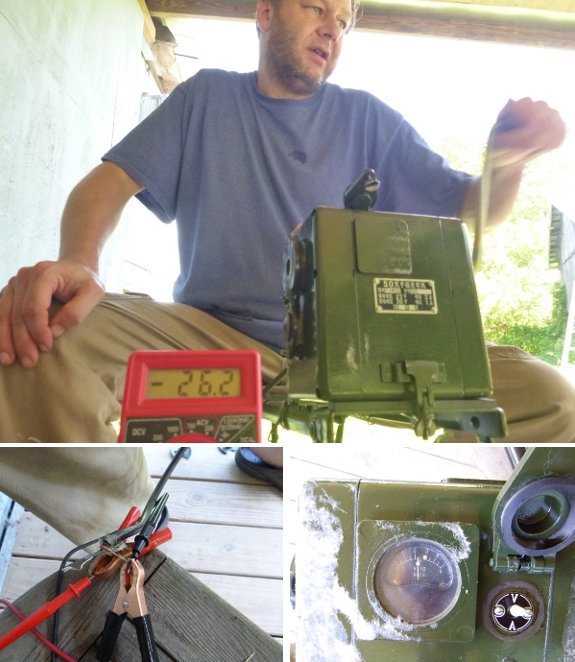
Hand cranked military generator modification

An old hand cranked Chinese
military generator found its way back to us recently. (More on those
details tomorrow.)
It was designed to power Army
radios in the field. Cutting the 4 pin cable reveals black, red, and
white wires. The red and white wires equal 30 regulated volts at 1 amp
and the red and black outputs 25 regulated volts at 2 amps.
I'm surprised at how
little effort it takes to create 12 to 15 volts. The first experiment I
want to do is hook up an additional voltage
regulator/charge controller
to try charging a golf cart battery.
Want more in-depth information? Browse through our books.
Or explore more posts by date or by subject.
About us: Anna Hess and Mark Hamilton spent over a decade living self-sufficiently in the mountains of Virginia before moving north to start over from scratch in the foothills of Ohio. They've experimented with permaculture, no-till gardening, trailersteading, home-based microbusinesses and much more, writing about their adventures in both blogs and books.
Want to be notified when new comments are posted on this page? Click on the RSS button after you add a comment to subscribe to the comment feed, or simply check the box beside "email replies to me" while writing your comment.

Try to put a sprocket on the axle instead of a hand-crank and hook it up to your training bike. You're bound to get more power output that way. Two legs will beat one arm.
If you have a 1000 Wh battery, and a generator that puts out 50W in the best case, you'll be cranking for at least 20 hours. You rather than me!
Of course you could set up a couple of training bikes with generators and call it a fitness club. Then you can have people pay you to charge your batteries.
Is "much little effort" more like much effort or little effort?
I remember thinking it was super hard to pedal hard enough to turn on the lightbulb at the science museum when I was a kid, but I have no idea how much power that actually took. (Power? Current? Not even sure.)
Nayan --- Google "chinese military hand-cranked generator." For a while, they were being sold here but are not currently: http://www.cheaperthandirt.com/ItemDetail.aspx?sku=MIL-2132
Roland --- So, the question is, what kind of use would you recommend around a homestead for a generator like this?
Amy --- Thanks for noticing that. Mark and I usually clean up each others' typos pretty well, but I guess I fell down on the job today. That would be "how little effort."
That would be "how little effort."
Continuous human power output is quite limited and not lineair.
An average healthy human male might sustain 300 W for a minute or two, 150 W for an hour or so. And maybe 75 W for a whole day.
So you could e.g. use the generator to:
But there are the inefficiencies of a generator/conversion/transmission to consider. I would guess you'd lose at least 20% of the energy you generate.
And the efficiency of the human body itself is around 25% IIRC. So the best thing it would do is probably keep you warm in winter.
Most human power applications use the mechanical power directly. Like bicycles, water pumps et cetera.
Human powered equipment like pole lathes and drills were common before electricity became widespread.
In support of Roland's comment: http://www.lowtechmagazine.com/2011/05/bike-powered-electricity-generators.html
According to the article, it takes 2-3x more effort to generate electricity to run a motor that runs a machine than to directly power the machine by pedal cranking. Of course, we can't directly crank a light bulb or pedal a tractor very effectively, so it would be nice to be able to charge your battery by human effort in a pinch.
[That Low Tech Mag is a very interesting site that debunks many of the myths we TreeHuggers hold dear. How can it be that a concept becomes "bunk" only after it has been "de-bunked?"]
My guess is that this ranks as a cool doo-dad play-toy than anything practical.
When Mark was wee lad, he was forever taking things apart to see how they work.
dirk (the brother)